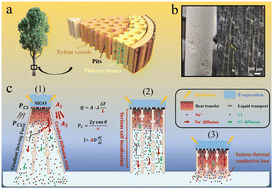Designing a solar interfacial evaporator based on tree structures for great coordination of water transport and salt rejection†
Abstract
Solar interfacial evaporation has been receiving increasing attention but it is still a huge challenge to achieve excellent coordination between efficient water transport and salt rejection. Here, unlike the common wood-inspired evaporators with equal-diameter directional pores, we have constructed an integrated structure with highly connected gradient pores that mimic the xylem vessels and phloem sieve tubes found in trees. The bio-inspired structure can reduce the resistance of water transport and salt rejection in the same channel. The average transport speed of the 6.5 cm high (2 cm in diameter) porous structure reached 1.504 g s−1, and water was transported 16 cm after 100 seconds. Using multilayer graphene oxide as the photothermal conversion material, the evaporators with different heights can work for more than 9 hours under the condition of 1 sun illumination and 23 wt% brine without any salt crystallization, and the evaporation rates range from 3.28 to 4.51 kg m−2 h−1, with the highest energy utilization efficiency of about 80%. When used in heavy metal treatment, the rejection was greater than 99.99%. This research provides a simple but innovative design idea for evaporators and is expected to further expand the application of solar interfacial evaporation.



 Please wait while we load your content...
Please wait while we load your content...